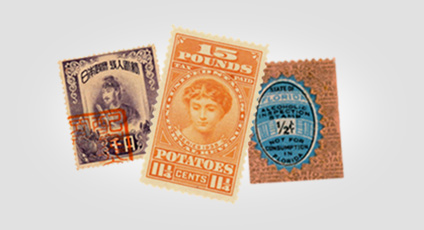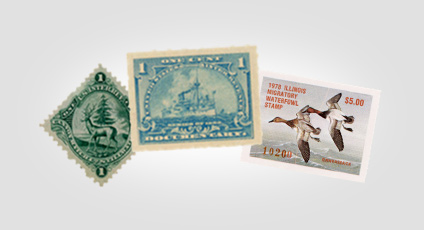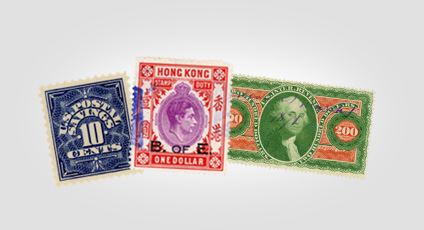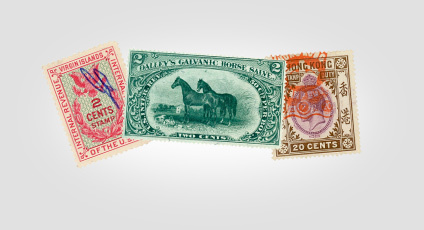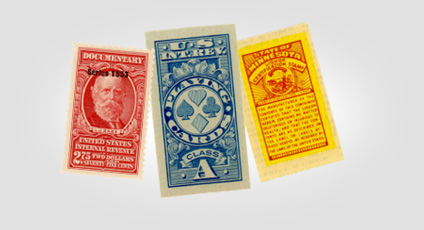Puerto Rico Revenues
Catalogue Files
- Puerto Rico Revenues I — Documentary (PDF)
- Puerto Rico Revenues II — Domestic Tobacco and Alcohol (PDF)
- Puerto Rico Revenues III — Tobacco Exported to the U.S. (PDF)
- Puerto Rico Revenues IV — Alcohol Exported to the U.S., Misc. Revenues and Association/Trade Stamps (PDF)
- Puerto Rico Revenues V — Municipals, Essays, Proofs and Specimen (PDF)
Update: September 2, 2019
Besides numerous cosmetic updates, the following changes have been made since 5/21/2019:
- Rouletted 5c with serial number given a separate listing (volume I)
- Documentary issue of 1939 found to have dollar values watermarked (volume I)
- New listing for “CATTLE FEED” stamps without the “SPECIAL TAX” overprint (volume I)
- Egg Inspection stamps revised (volume I)
- New Cigar Band stamp added, “GOBIERNO...”, 3 IN. (volume II)
- New Cigarette stamp added for Series 1921 surcharged “16 CIGARETTES...” (volume II)
- Cigarette stamps for “Series 1941 separated by stamp color (volume II)
- Distilled Spirits stamps with “IMPUESTOS SOBRE EXISTENCIAS...” varieties added (volume IV)
- New Cigar for Export to the U.S. added for Series 125 Class G cigars (volume III)
- New red bottle stamp image for Distilled Spirits Export to the U.S. RBS6 (volume IV)
- Collegio de Abogados / Impuesto Notarial stamps reorganized (volume IV)
- Collegio de Peritos Electricistas stamps reorganized (volume IV)
- Additional entries made for Collegio de Technologos Medicos issue of 2000 (formerly 1998) (volume IV)
Update: May 21, 2019
Besides numerous cosmetic updates, the following changes have been made since 3/18/2019:
- Added new section in General Documentary issues for 1986 issue and modified date for 1986 issue to 1988 (volume I)
- Add listings and scans for new color varieties for 1978 and 1988 General Documentary issues (volume I)
- Moved Matches from Documentary to Appendix B (volume I)
- Revisions made to Distilled Spirits “MENOS DE ½ PINTA” issues (volume III)
- Additional listings added under Cigars Exported to the United States (volume III)
- Moved Lock Seals from Alcohol to Appendix A (volume III)
- Moved Customs from Tobacco Products for Export to U.S. to Appendix A (volume III)
- Additional type of Digital Stamp added in Miscellaneous (volume IV)
- New type of “Permits” added to Miscellaneous (volume IV)
- New type of “Weights and Measures” added to Miscellaneous (volume IV)
- Created Appendix C for Distilled Spirits Bacardi date cancels (volume IV)
The following chapters were extensively revised:
- Class A Cigarettes Exported to the United States (volume III)
- Class A Cigarettes Exported to the United States without the “PORTO RICO” overprint (volume III)
- Distilled Spirits Exported to the United Stated (volume IV)
Bibliography update:
- Added Springer catalogue references to Bibliography
Catalogue of Puerto Rico Revenues
By Gregg Greenwald
A catalogue has been created to organize and categorize the revenue stamps of Puerto Rico issued under U.S. administration. The effort was started in September of last year and, thus far, has received positive reviews. However, more reviews and insights are needed from collectors to help fill in some of the gaps that are either incomplete or missing altogether.
For background, I have been actively collecting U.S. revenue stamps since the mid-1980’s. I avidly pursue non-catalogued varieties and have added many new listings to the revenue section of the Scott Specialized Catalogue. Approximately 10 years ago, I started to collect the Puerto Rico Rectified Spirits revenues as I thought that, except for one variety, completion was possible. Then I discovered that there was a vast group of handstamped provisional issues as well, and the chase was on. In my pursuit of the provisional issues, I obtained a modest collection of possessions revenues (both U.S. and Spanish) in 2012. Included in the collection was a large group of revenues from Puerto Rico that I had never seen before. They appeared to resemble U.S. revenue stamps with the exception that many had a Spanish twist. Fortunately for me, the previous owner had notes mentioning a catalogue by Charles Chabot. After purchasing a section of the Chabot catalogue referencing Puerto Rico revenues, I made the decision that the pursuit of these revenues might be fun. How hard could this be? It has been, in no uncertain terms, a learning experience. I had to take several crash courses in U.S. Taxpaids including how to differentiate paper colors and the surcharges of 1917 and 1918. I also had to comprehend just what a “Collegio de Abogados” was and why did they have stamps.
My experience with the Chabot catalogue turned out to be woefully inadequate. While it helped me initially organize my additional acquisitions, there were too many instances where I was saying to myself “that’s odd” where I would find something that was similar to what was in the Chabot catalogue but was somehow different. Even worse, there were too many instances where I was not even certain whether a particular stamp was even a Puerto Rico revenue stamp.
At the APS StampShow held in Columbus, Ohio, last August, I was again voicing my exasperation of trying to get a handle on my Puerto Rico revenue collection to the revenue dealer Eric Jackson when he mentioned again (he had mentioned it for the last couple of years but I simply was not listening) that I should produce a catalogue. Fortunately, there were also a few collectors at the show who were willing to assist my effort by sending me scans of their collections for me to study and integrate into the catalogue. I took my first draft to CHICAGOPEX in November and presented it to Eric. He thought that it was an excellent start and said that I should continue. Additional collectors have volunteered scans of their collections for further study.
I have reorganized the Chabot catalogue and broken the new catalogue into the broad sections of Documentary, Tobacco, Alcohol, Miscellaneous (Digital Stamps and Meters), Association / Trade, Municipals and Essays/Proofs/Specimens. There are currently over 200 pages of listings including scans. I have tried to put emphasis into areas where I found myself having the most difficulty in trying to organize my holdings. I have included an abundance of scans of stamps that have been difficult to understand or were rarely seen in my past decade of collecting these issues. Much more work still needs to be done.
I highly recommend visiting the ARA website at https://www.revenuer.org/technical-articles.asp and download the current version of the catalogue. Print out the sections of interest and compare them with your holdings. A few general notes to keep in mind when reviewing the catalogue:
- Dates of issue, along with, at time, the proper sequencing of issues, has proven to be difficult. Rarely do the stamps have a date as part of the cancel. In addition, fiscal history for many of the issues may simply not exist. When possible, dates of earliest documented usage is given with a ‘?’.
- Documentary stamps with the “SPECIAL TAX” overprint and additional specific purpose overprints are listed. However, while the stamps were printed, distributed and likely used, none may exist in collectors’ hands. The question remains whether to list the stamps with the possibility that they exist or to list only those observed and footnote the list of remaining possible values.
- Likewise, the stamps related to Tobacco products are likely to only have scratched the surface. Many additional values as well as additional types not listed are likely to exist.
- Stamps for Distilled Spirits and Wine issued during the 1960’s and 1970’s were issued with and without watermarks. Scans of several collections have been viewed, but it is impossible to determine whether a stamp is watermarked. Help is needed to determine which varieties are watermarked and which are not.
- Information regarding revenue stamps issued in the last 50 years is scant. The listings included here include those that have been observed. Entire classifications not covered here are likely to exist. While the stamps may appear to be insignificant to those who reside in Puerto Rico nothing like this is in use by those of us who reside in the states! Any examples and insights into their use are always of interest.
I welcome your feedback after reviewing the catalogue. In no way do I claim that it is perfect and could certainly use polishing by a good editor. I do, however, feel that it is a giant step forward in what is currently available to collectors. I am currently awaiting feedback from additional collectors who have large holdings and can confirm and/or refute many of the questions that I have regarding some issues. Once this feedback has been received I will start to assign catalog numbers and firm up the listings as I will have more confidence that large sections of certain troublesome issues have not been neglected.

